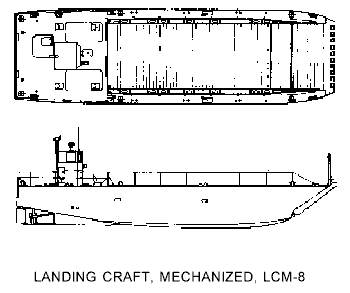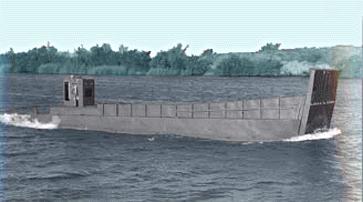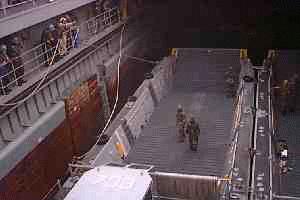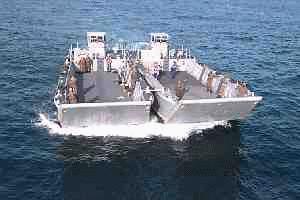







The LCM(6) is intended primarily for the transport of cargo and/or personnel from ship-to-ship and ship-to-shore. The craft is a 56-foot twin-screw, welded-steel craft with forward cargo well and bow ramp. The design of the boat permits its transportation aboard larger vessels.
In 1959, the LCM-3 was replaced with the larger 70 ton LCM-8. LCM-8 are manned by a four man crew, Boatswainmate Petty Officer, Enginerman Petty Officer, and a nonrate fireman and seaman. The LCM-8 is constructed of steel and powered by two 12 V-71 diesel engines. The LCM-8 has twin screws and rudders, which can be controlled from the pilothouse. LCM-8 is built of welded steel; it's bottom, however, is semiflat.



Specifications | ||
| LCM-6 | LCM-8 | |
| Length Overall (nominal, hull) | 56 ft. 0 in. | 73.7 feet (22.5 meters) |
| Beam (nominal, over guards) | 14 ft. 4 in. | 21 feet (6.4 meters) |
| Draft (max. full load) | 4 ft. 3 in. | |
| Hoisting Weight (max) | 69,600 lbs. | |
| Displacement (full load, approx.) | 137,600 lbs. | 105 tons (95.5 metric tons) full load |
| Fuel Capacity | 768 gals. | |
| Cargo Capacity | 68,800 lbs. or 80 troops | 1- M60 tank or 200 troops |
| Propulsion Engine (hp) | 600 shp per engine at 2300 rpm | 2- Detroit 12V-71 Diesel engines; 680hp sustained; twin shafts |
| Speed | 9 kts (10.3 mph, 16.6 kph) | 12 kts (13.8 mph, 22.2 kph) |
| Range | 130 miles at 9 kts | 190 miles at 9kts full load |
| Crew | 5 persons | |
| Hull Construction | Steel | |